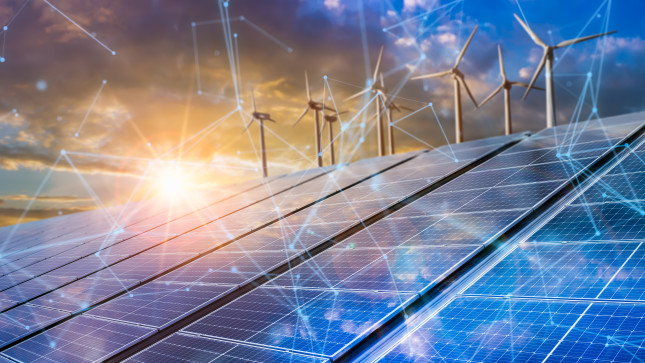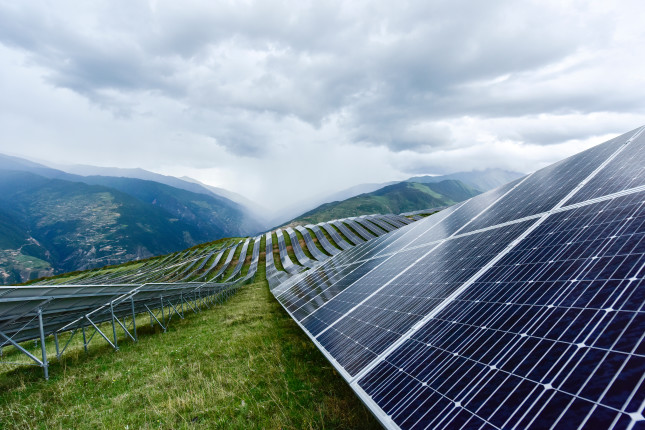-
China’s “New Energy Cloud”
January 27, 2022 By Eli PattonCriss-crossing the expansive nation from the icy northeast to the dry deserts of the far west and into the mountain jungles of the south, China is constructing the world’s largest ultra-high voltage power grid, connecting distant coal, wind, solar, and hydro to energy-hungry east coast cities. Beijing recently ordered vast numbers of batteries to be connected to the grid—batteries that can store excess wind, solar, and other renewable power, and then dispatch it as needed. This “New Energy Cloud” provides the flexibility in the power grid that is required for finally dethroning old king coal. However, zapping coal power long distances doesn’t exactly solve the climate problem.
Most of China’s CO2 emissions—which account for 27 percent of global CO2 emissions, making China the world’s largest emitter—come from the energy sector. Energy consumption in China has quadrupled over the last twenty years, surpassing the United States in 2008. State Grid, the government-owned enterprise responsible for building and maintaining China’s power lines, has a plan to solve the coal problem.
Greening the grid, grid-ing the green
Under construction for more than a decade, China’s supergrid is unlike any other power grid in the world. Its UHV lines can transmit energy longer distances than conventional power lines used in the United States and Europe. This is crucial because, while Xinjiang has plenty of wind and sun, grid choke points mean that seven percent of the renewable energy produced is not used. However, thanks to the supergrid, remote and less-developed provinces, such as Yunnan, can ship excess hydropower to megacities like Shenzhen and Guangzhou.
In total, China has constructed at least 18,000 miles of UHV power lines, enough to stretch from New York to Los Angeles six times over, at a cost of over six billion dollars. The first trunk of the supergrid is over 1,400 miles long, running from Gansu to Hunan, and was switched on for the first time in 2019.
Power lines, however, are just the first phase of the project. The long term goal is to be able to dispatch energy anywhere at any time without depending upon dirty fossil fuels, which have long been the baseload of the power system. Just like all of our data is stored in the cloud, if China’s grid is big enough and there is enough battery storage, wind, and solar throughout, then the grid will be flexible enough to dispatch renewables faster and more easily. China could then come closer to creating a green “virtual power plant,” or what State Grid Chairman Xin Bao’an dubbed a “new energy cloud.”
As Max Dupuy from the Regulatory Assistance Project noted at a recent Wilson Center public panel, China’s energy transition game plan has had several goals over the last decade, from increasing energy efficiency across the economy, to market policy reforms that incentivize energy trading, and more. However, all of those steps combined still do not stop coal—they only reduce fossil fuel consumption or move it elsewhere. In their September 2020 report, Innovation in batteries and electricity storage, the International Energy Agency projects that policy reform, markets, and renewables alone—without battery storage—will reduce emissions by about two-thirds by 2050, which is still only halfway to net zero.
Storing power in the cloud
China’s installed battery storage has skyrocketed over the last three years and is expected to continue to climb upward to 35 GW by 2025. Adding to the fervor, in spring of 2021, China’s National Energy Administration ordered grid companies to establish linkages to battery backups and identified several projects that attach storage to grids and serve as national examples to be followed.
One such example is Xinyi Solar, a solar panel producer and management company that recently announced it will add nearly 50 MW of battery storage at its solar farms over the next three years. Also, the major city of Dalian, in Liaoning Province, is building a huge 800 MWh battery to serve as a local backup for residents. Aside from these massive-scale projects, the energy cloud can grow in the consumer market as well, providing “complementary integration” paths.
One such path is batteries in homes. China’s largest e-shopping website has pages and pages of home kits for battery electric storage, with some reaching millions in sales. This is part of a global trend of behind-the-meter battery storage that has doubled in the last ten years and now accounts for nearly half of all installed battery storage capacity. Electric cars, too, are adding to the cloud and four out of every ten electric vehicles sold in the world are sold in China.
Importantly, battery production is scaling up to meet all of this demand. Steel giant, Tsingshan Holding Group, is investing billions into battery production with aims of annual output reaching 30 gigawatts in Guangdong and another 16 gigawatts in Zhejiang. China’s largest battery manufacturing company, CATL, which produced 50 GW of battery storage last year and recently announced a 15 percent growth in sales, is making major investments in lithium mining companies abroad in Canada, Germany, and in the Democratic Republic of Congo.
Dethroning old king coal
China State Grid plans to increase renewable sources such as wind and solar to at least 30 percent of electricity by 2030, which will be a huge step toward displacing coal and over the long run will save billions of dollars in stranded renewable power assets, public health, and environmental damage avoided.
While the sheer number of batteries needed to create the “new energy cloud” is enormous, it is financially possible as the prices of batteries have fallen dramatically over the last decade. In just one year alone, 2017 to 2018, the levelized costs of electricity (LCOE) for batteries fell by 85 percent.
For China and the world, the energy transition will not be achieved by only reducing demand, or building longer power lines, or installing more renewables. University of California San Diego China energy analyst, Michael Davidson, in a recent private interview with CEF, said: “It’s great to have the hardware, but if you don’t have the software including markets to run it, it is going to be less effective.” It is the combination of energy conservation, grids, markets, policies, and batteries, that will finally kill old king coal.
In order to meet Xi Jinping’s net-zero carbon goal by 2060, this is precisely what Beijing intends to do. In a recently released white paper, executive vice chairman of the China Electricity Council Yang Kun, said the “core body” of China’s new energy system is a smart grid, with battery back-up, and powered by clean energy. The future of clean electricity is here.
Eli J. Patton is a researcher at Wilson Center’s China Environment Forum. His work is related to the Belt and Road Initiative and the impact that a powerful China has on its neighbors, their societies, governance, and ecosystems. Eli earned an MA in Asian Studies from George Washington University and previously worked as a journalist and translator in Taipei city.
This article is part of a new series of blogs and events focused on China’s decarbonization challenge from the Wilson Center’s China Environment Forum. Upcoming topics will include China’s supergrid development, national carbon trading scheme, the boom in renewables, a Green BRI, and more.
Click here to sign up for our newsletter and be notified of our upcoming events.
Sources: ABC, Alibaba.com, Argus Media, BBC, Bloomberg, Caixin Global, China Dialogue, CMOC, Columbia SIPA, EE Times, Energy-Storage News, European Union, Forbes, Ford Motor, Global Times, IEEE Spectrum, IEA, Jamestown Foundation, Nature.com, IRENA, New York Times, Our World in Data, Popular Science, PV-Magazine, Reuters, shupeidian, Sina Web, South China Morning Post, The Economist Intelligence Unit, United Nations, Whitehouse, Xinhua, Xinyi Solar, Youtube.
Lead Photo Credit: Solar panels and wind turbines with a graphic of a grid overlaid, used with permission courtesy of Fit Ztudio/Shutterstock.com.
Topics: China Environment Forum
 A Publication of the Stimson Center.
A Publication of the Stimson Center.








